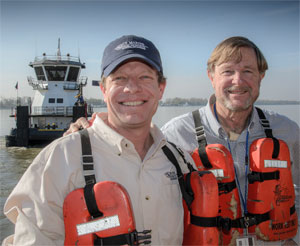At the age of 10, Corning Townsend began a life immersed in the maritime world. Working his summers as a galley boy under Capt. Irving Johnson on the brigantine Yankee, the young Townsend, mentored by the legendary mariner, rose to third mate in three years aboard.
Today, the 73-year-old Townsend is easing off of a 60-hour workweek, passing more of the business over to his son, Christian. From his perch in Edgecomb, Maine, Townsend can look back on a distinguished career as a naval architect and the founder of CT Marine.
Following a soccer accident in his senior year of high school, Townsend dropped out and went back to sea for what he calls “the best year of my life.”
After a stint in the merchant marine, Townsend enrolled in the naval architecture program at the University of Michigan, graduating with a bachelor of science degree in naval architecture and master’s degrees in naval architecture and marine engineering. He also holds a U.S. Coast Guard 200-ton master’s license for power and sail on both inland rivers and oceans. He has been a professional engineer for 30 years and was elected to fellow in the Society of Naval Architects and Marine Engineers for “outstanding personal contributions to naval architecture.”
In the late 1960s, Townsend was the guest scientific officer at the Netherlands Ship Model Basin (NSMB). As a project manager, testing model performance for Dravo, Jeffboat, St. Louis Ship and Nashville Bridge, the big four riverboat builders in America, Townsend met many of the people who would later become his clients at CT Marine. Upon his return to the U.S. in 1969, he worked under the wing of the late Clancy Horton, who is credited with developing the modern towboat.
Horton had gone to Germany in the 1930s to study the Kort nozzle, invented by Ludwig Kort. “The shroud placed around a towboat propeller was first introduced in Germany about 1920 to reduce erosion of the river banks,” said Townsend. “But they found by accident that it increased thrust. Clancy Horton brought the patented (type 19A) nozzle to this country in 1937 as chief naval architect at Dravo and installed it on the Dravo Pioneer. I worked for Mr. Horton for eight years starting in 1968. It was at that time when we designed the type 37 nozzle for a pair of ship-docking tugs in Aruba.”
The type 37 nozzle provides near equal thrust ahead and astern, which was a marked improvement for river operations. “For the next 15 years the 37 was used on river towboats as it produced better backing and flanking with much less vibration astern than the 19A,” said Townsend.
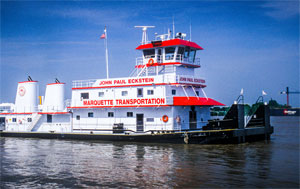 |
|
The CT-designed John Paul Eckstein offered breakthroughs in propulsion, steering and vibration control when it launched in the 1990s. |
In 1978, Townsend formed CT Marine. His client list grew, leading to a portfolio of engineering and design innovation that includes most of the significant riverboats of the past quarter century and articulated tug-barge (ATB) hull design.
“I’ve worked with Corning for 35 years, on projects when I was working at Jack Gilbert’s office,” said Robert Hill, owner of Ocean Tug & Barge. “He works on the barge hull shapes for ATBs but he has a great reputation designing river towboats and has a ton of knowledge when it comes to ocean barge hull shapes. He’s done all of our model testing at the model basins in the Netherlands and at St. John’s, Newfoundland. We have collectively run more ATB model test programs than any other design team in the business.”
At Ocean Tug & Barge, Townsend was contracted to work on ATB barge hull shapes for such clients as Interstate Oil Transport and Maritrans, both acquired by OSG in 2006, while developing 192- and 210-foot barges. “And (he) played a huge part in shaping the hull on our 342,000-bbl barges that OSG built,” said Hill.
“Our current barge designs are all designed based on a double-chine, CT Marine-based hull design that has been very successful both speedwise and in maneuvering. We collaborated on many ATBs in the past, including units for Mobil, Penn Maritime, Vane Bros., OSG and others and we continue to do so today.”
In 1998, the firm developed the CT28 nozzle and in 2009, the CTSL. “They were designed specifically for river towboat application,” said Townsend. “We have installed about 150 sets of these nozzles and only about 10 percent of our towboat designs are open wheel.”
The CT28 has similar backing characteristics to the type 37 nozzle and yields an increase of 4 or 5 percent ahead efficiency. CT Marine also developed the CT EZ Flow strut, a strut that is both canted and twisted. “This has no effect on performance but minimizes the nozzle erosion, which is common with a highly loaded propeller at the 11 and 1 o’clock positions and at the 5 and 7 o’clock positions, depending upon propeller rotation,” Townsend said.
The draft restrictions encountered by a towboat plying the Mississippi River make it impossible to have the optimum diameter propeller above 2,500 bhp per shaft, explained Townsend. During nine years of testing in the model basins, he became aware of the causes of cavitation. Later, working with Clancy Horton and in shipyards, he witnessed its effect.
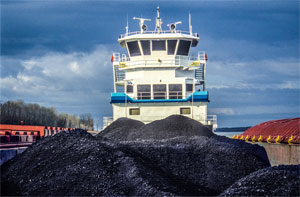 |
|
Subsequent CT Marine-designed inland river boats, including Christopher M. Parsonage, feature sprung superstructures and accommodations, improving crew comfort. |
“CT Marine has designed every high-horsepower towboat of 7,000 to 9,000 bhp for U.S. waters since 1988,” he said. “There is no magic bullet to minimize cavitation at high propeller loading. Rather, it is accomplished in the design details of the hull, flanking rudders, struts, nozzle fairing, appendages and propeller characteristics.”
“I’ve worked with Corning for over 30 years,” said Bobby Barthel, vice president of new construction at Bourg Dry Dock. Barthel, formerly at Quality Shipyards for 24 years, collaborated with Townsend on all six 8,000-hp towboats for Marquette Transportation and Memco Barge Lines (now AEP).
Barthel worked with Townsend on five 6,000-hp towboats for AEP at Quality Shipyards and five more at Gulf Island Fabricators after he moved there from Quality. The pair worked together on three 6,000-hp towboats for Pine Bluff Sand and Gravel and a pair of towboats, one each at Quality and Gulf Island Marine Fabricators, for Hunter Marine.
“He has many strengths: his ability to work with people and investigate every possibility to come up with the best solutions,” said Barthel. “It could be line-of-sight issues, visibility, livability, working out the nozzles, the water flow and placement of the rudders — making everything as efficient as could be. Another strength is making sure that the vessel floats right, draftwise. He doesn’t miss a thing in terms of putting together the best towboat and he always does what he says he’s going to do.”
Among the developments that CT Marine has introduced over the years are improvements to the steering rudder that require less angle, allowing the engines to maintain rpm through a turn. “In my mind, steering and stopping are at least as important as ahead performance,” said Townsend. “When we really need great steering and can’t use a z-drive, we go to two steering rudders per propeller. Not only does this increase the side force by 30 percent but it also allows for shaft removal without dropping the rudders.”
Commenting on the design of John Paul Eckstein for Marquette Transportation, featured in the 1997 issue of American Tugboat Review, Townsend emphasized that his focus regarding the steering and propulsion details was to maximize the steering control, the efficiency of speed and fuel consumption, and minimize noise and vibration. The goal was to maintain 900 rpm through a turn, combating the effect of the rudders blocking water flow.
Towboat watchers along the inland river system can spot the signature shape of a CT-designed pilothouse, one with full vertical windows canted against reflections. Looks aside, visibility is an important safety feature, taken a step further with the implementation of the split console that allows the pilot to walk right up to those expansive windows and look down on the push knees, face wires and the tow. Safety is the paramount benefit, but there is also an aesthetic achieved — “eye candy” on the river.
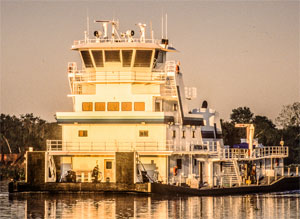 |
|
CT Marine designed the 8,000-hp line- haul towboat Patricia Gail for Memco Barge Lines, now part of AEP. |
As the call for safer conditions has increased in the past few decades, so too has the need for creature comforts for crews living 50 percent or more of their lives aboard.
“There is little romance left for the crews working on the towboats plying the Mississippi. No stopping along the way, no parties, just very hard, dangerous work, often done in the snow at the end of an 1,800-foot tow,” said Townsend. The result of that isolation, living and working on a floating home away from home, has consequences when it comes to retaining crewmembers.
“The naval architect must do everything possible to make each boat safe and comfortable for the crew,” said Townsend. Comfortable quarters, good food, entertainment technology and communications are becoming standard on most newbuild vessels. So too is the trend toward soft-mounted machinery, floating floors above machinery areas and sound insulation throughout the vessel, all directed toward dampening the head-thumping, soul-numbing noise and vibration so common in vessels of not so long ago.
Power and performance aside, the other big news surrounding John Paul Eckstein was the installation of a sprung superstructure, an innovation that virtually eliminates the vibration and noise that 8,000 hp and highly loaded propellers can create. The technique involves mounting the entire accommodation house on up to 40 very robust springs set in a 2-foot-high separation cavity above the main deck that is enclosed with a rubber curtain. The Marquette line-haul boat was followed by Patricia Gail, Christopher M. Parsonage and Joy Anne Keller for Memco Barge Lines, and Bootsie B for Riverway Co. (both companies now owned by AEP). A dozen 6,000-hp riverboats with sprung superstructures were designed by CT Marine for the Pine Bluff Sand and Gravel and AEP fleets.
“This was first done on the rivers on a Luhr Brothers boat and soon thereafter on a vessel for Mulzer Crushed Stone,” said Townsend. “Every new CT Marine towboat, 6,000 bhp and above, has accommodation isolation. When done well, the results are like sitting in your living room, even at full horsepower. This assures good crew rest, which in turn increases safety and instills pride in the boat. Inside the sprung accommodations, the ambient noise is 62 dba or less and there is virtually no vibration. The major complaint is that the pilot cannot feel when the engines have clutched into reverse.”
In 2013, CT Marine took crew comfort another step further with the delivery of Ron Hunter, an 8,000-bhp towboat, built by Gulf Island Marine Fabricators, with a 300-ton accommodation house floating on 48 air bellows. “In addition, Loggers NL, the Dutch designer and manufacturer of the isolation system, fitted 14 shock absorbers to further control any unwanted motion of the house,” said Townsend. “It is by far the most comfortable 8,000 on the river.”
The Coast Guard’s Notice of Proposed Rulemaking (NPRM) to 46 CFR Subchapter M continues to loom large within the U.S. maritime community. The application is expected to impact a broad range of workboats, including ocean tugs, harbor tugs longer than 26 feet and towboats plying the U.S. inland river systems. Addressing the variables with a universal set of regulations is a concern within the riverboat community.
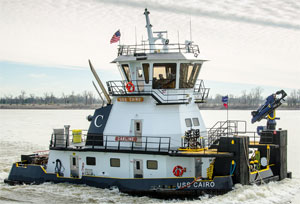 |
|
Christian Townsend designed USS Cairo, the U.S. industry’s first purpose-built z-drive fleeting boat, for Carline Cos. The vessel entered service this year. |
“For example, being able to control the rudder from the rudder room on a tug in the middle of the Pacific is different than trying to steer a pushboat from the rudder room southbound through Vicksburg,” said Townsend. “Hopefully the final rules will have a few more distinctions based upon service such as, but not limited to, intact and damage stability requirements for river pushboats.”
The regulations and innovations applied to riverboats in the next 73 years are difficult to predict but one change is being ushered in as Corning Townsend is easing himself out. Z-drive propulsion, now practically a requirement on a new tugboat assisting ships, is becoming a serious consideration on riverboats. Last fall, Carline Cos. of Gonzales, La., completed the construction of USS Cairo, the first purpose-built z-drive fleeting tug in the U.S. Christian Townsend took the lead, designing the tug with input from Corning, signaling the transition from father to son at CT Marine.
“Christian and I have been working as a team for the last 22 years,” said Corning. “He is a very capable designer with great imagination for the use of restricted space, and a profound understanding of the importance of structural continuity. Christian is extremely detail oriented whereas I enjoy broad-brush design and engineering, observing trends, life cycle economics, hydrodynamics and transportation systems as a whole. With nearly a quarter century of daily discussion, teaching and learning from each other, we have developed towboat designs from 500 to 10,000 bhp that complement our capabilities and optimize the tradeoffs that are inevitable in ship design.
“With nearly 200 towboats working in four continents, it is as easy to spot a CT Marine design as it is a Dravo or St. Louis Ship. Over the past 38 years we have not just created some of the most efficient state-the-art towboats, we have created a brand.”

